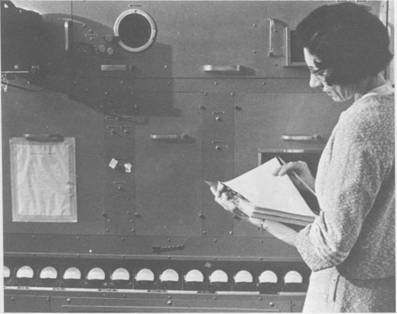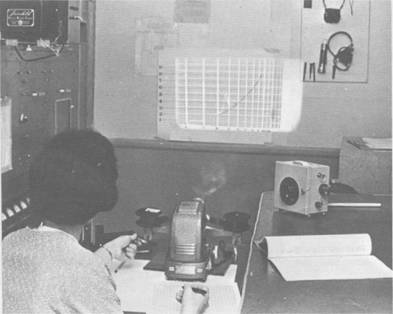|
1967
Eavesdropping On Silence
Norine Allen of Ottawa listens to what
cannot be heard, at a distance of from
55 to 250 miles. Give up?
|

Norine
follows the
ionoscope's
operations
and
"scales" the film it
takes.

|
She is Canada's only female in a
small group of Telecommunications and Electronics Branch technicians who take soundings of the ionosphere, a layer of
ionized particles which blanket the
earth and, among other things, permit long-distance radio broadcasts.
Knowledge of conditions current in the
ionosphere is important for the
efficient operation of communications with ships, aircraft, lighthouses-with all of which
D.O.T. has responsibilities - and,
indeed, almost every kind of radio communication.
This strange, invisible sphere is in a
state of continual change. In
sunlight it gradually spreads into three layers. The inner one about 55 miles high, the outer extending to
some 250 miles. As night falls, the
upper and lower strata gradually converge until a single layer results.
Sun spots, among other factors, have a marked
effect on the behaviour of the ionosphere.
Radio waves, generally, are deflected from
the ionosphere back down to earth, thus enabling a radio message to travel as far as 2,000 miles or more. Much
depends on the wavelength, however,
for under certain circumstances some frequencies are absorbed into the ionosphere wholly or
partially, resulting in a weak signal
or none at all.
This is where Norine and her ionosonde come
in. Every 15 minutes the ionosonde,
like 50 others in various parts of the world, sends a series of electronic pulses
straight into the ionosphere. The
electronic "echoes" are recorded on film which, when developed, Norine puts in a projector to
"scale", taking off certain information to put on a graph and code into
digital form. The information includes the
height of the ionosphere and its
reaction to different electronic frequencies. Analysis of such specific
properties of the ionosphere, as reported by an extensive network of ionosondes, permits forecasts of
conditions for a week or 10 days.
This enables short-wave stations to choose, from among the frequencies allotted to them,
the ones which will get the best
bounce, or "skip", from the ionized ceiling.
The Department maintains five "sounding"
stations. Located at approximately 47
degrees of latitude are Kenora, Ottawa and St. John's, Newfoundland. Kenora also is in
line perpendicularly with stations at Resolute and Churchill, on the
ninety-fifth meridian.
Norine and other technicians of the Ottawa
Station which is under the
administration of Ottawa Telecommunications Area Manager and is part of Toronto Region's
Maintenance and Operations Division,
Telecommunications and Electronics
Branch, have a unique double responsibility.
Results are sent to the maintenance and
operations division branch
headquarters, which sends daily reports to Fort Belvoire, Virginia, the world warning centre for
geophysical phenomena. Reports also
are sent to the centre of the American ionospheric group at Boulder, Colorado.
Like most of this select group of
technicians, Norine has had extensive radio experience. She first worked for
D.O.T. in 1944 at the Winnipeg monitoring station. This was followed by three years as a radio operator for the
Canadian army.
Next came permanent employment as wife of
Warrant Officer Ted Allen of the
Royal Canadian Corps of Signals which has involved over two years at Yellowknife, N.W.T., and postings to Edmonton and
Ottawa. They have two children - Patricia, 18, and Garth, 10.
In Edmonton Norine went back to radio work,
serving the Department of National
Defence's Northwest Territories and
Yukon radio system. She rejoined D.O.T. about a year ago.
|

